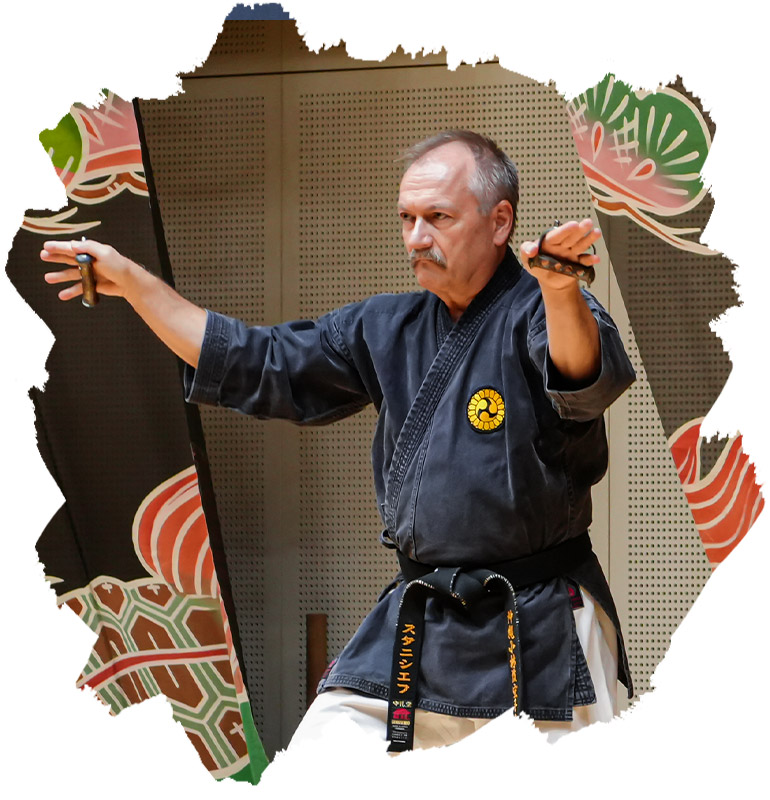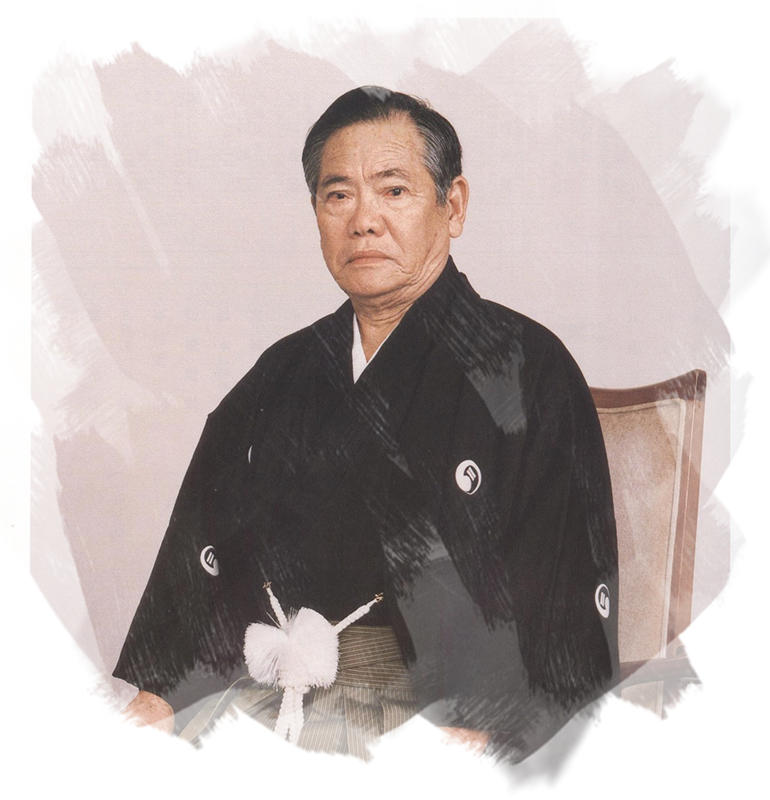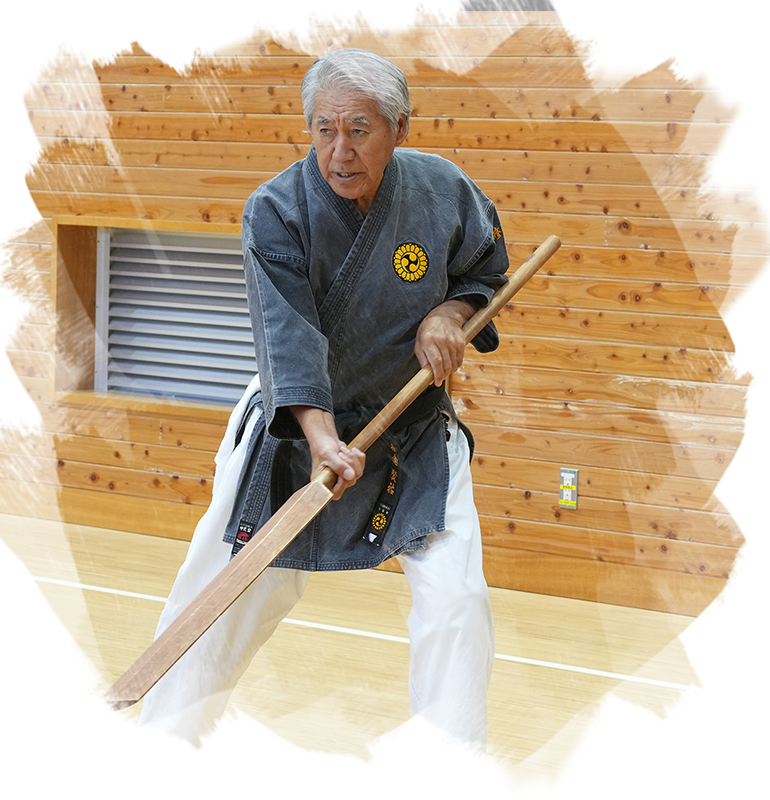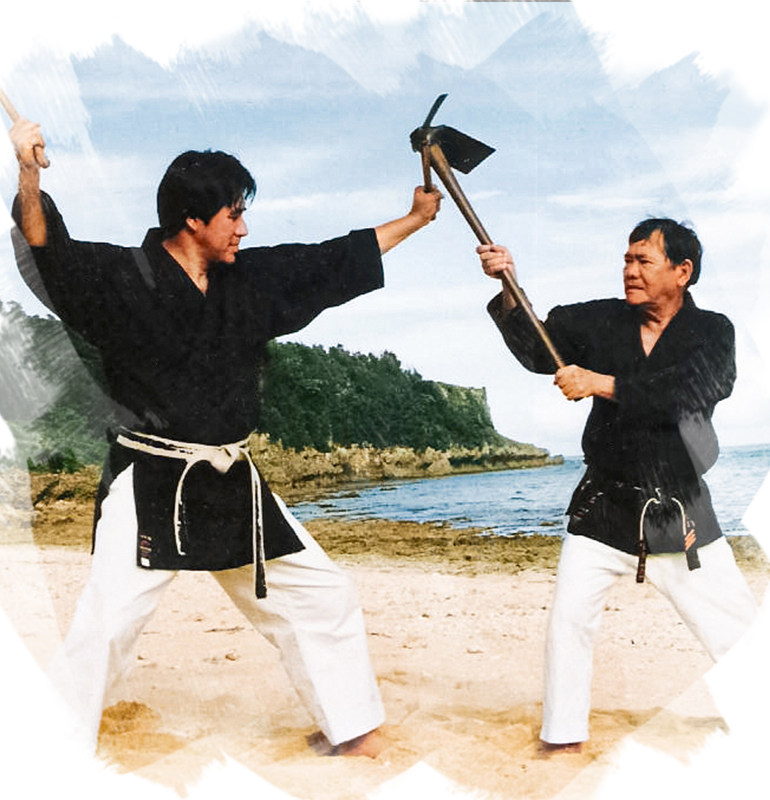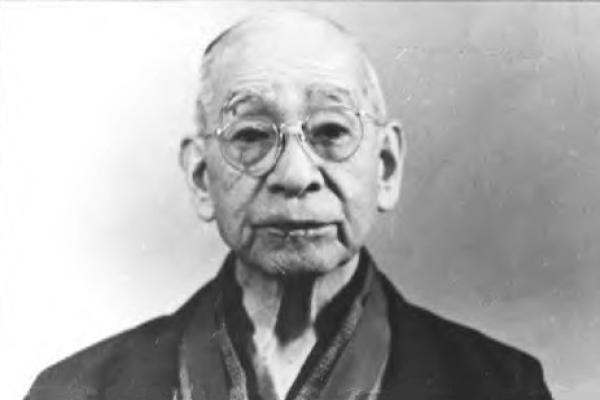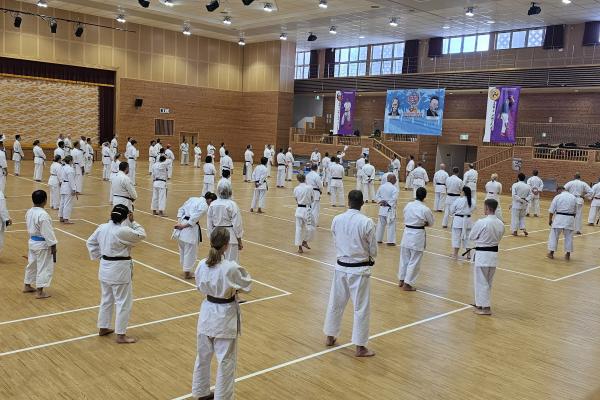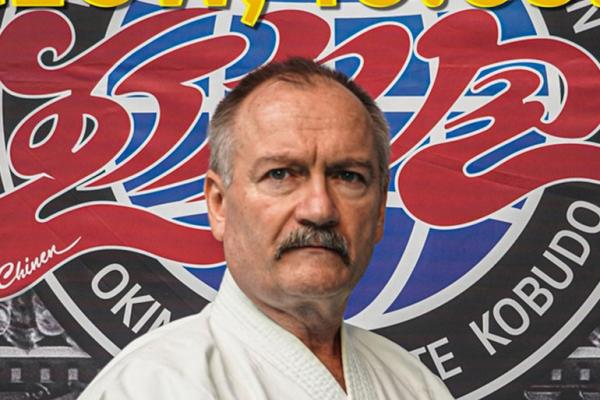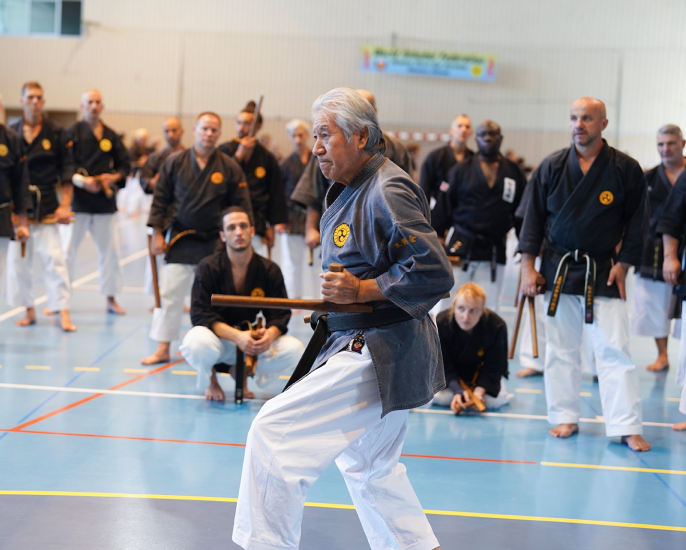
Kobudo
Kobudo is a martial arts discipline that focuses on the skill of using traditional everyday objects from Okinawa, transformed into weapons.
Kobudo is a martial arts discipline that focuses on the skill of using traditional everyday objects from Okinawa as weapons. It serves as a complementary aspect of unarmed combat training, such as karate. It's worth noting that in Okinawa, unlike in other regions, weapon fighting systems developed independently, not being an integral part of a larger combat system, as was the case in China, where weapon techniques were considered a complement to the fighting style. The term "kobudo" is composed of three Chinese characters, which can be translated as the "way of ancient martial arts." The skill of using various types of weapons was a separate discipline until the early 20th century when masters usually specialized in one or several types of weapons.
History of Martial Arts in Okinawa
In literature concerning the history of martial arts in Okinawa, it is widely accepted that the transformation of traditional agricultural tools and everyday objects into weapons occurred in response to the invasion of the Japanese Satsuma clan in the early 17th century. Although possessing sharp weapons was prohibited in Okinawa, it is uncertain whether this was the main source of inspiration for development of weapons adapted from everyday tools. However, some types of weapons used in kobudo were designed specifically for self-defense, and they were used not only by farmers but also by the middle and lower classes known as shizoku and pechin. Although many types of weapons used in kobudo are known in other parts of Asia, they were adapted to the specific conditions of the island and developed creatively in Okinawa. Just like with unarmed combat styles, the knowledge of kobudo was passed on in secret to select individuals because the element of surprise was a significant factor in determining the outcome of a fight. Often, the skill of unarmed combat or weapon use was kept as a family secret, passed down from generation to generation. This tradition lasted until the early 20th century when many masters realized that in a changing society, Okinawan martial arts could disappear. It was then that these fighting systems came out of closed circles and have survived to this day.
One of the richest weapon fighting systems in Okinawa is the Matayoshi family, founded by Matayoshi Shinko (1888-1947). In his youth, Matayoshi Shinko learned various types of weapons from different teachers, both in Okinawa and beyond. His skills in using weapons, especially the sickles called kama, were highly regarded. After his death in 1947, he passed on his skills to his son, Matayoshi Shinpo (1925-1997), who continued to teach and develop the system.
Matayoshi Shinpo - Key Facts from His Life
Shinpo Matayoshi, born on December 27, 1921, in Yomitan, Okinawa, as the second child in the family, began his martial arts education at a very young age, at just 4 years old. His father, Shinko Matayoshi, instilled in him a passion for martial arts and initiated his training. As Shinpo grew up, he continued his learning, traditionally studying under various masters, including karate under the guidance of Master Kiyana Chotoku, as well as learning from masters like Chojun Miyagi and Seiko Higa. Shinpo was also sent to study under Master Go Kenki, a significant figure in the martial arts world of Okinawa.
Despite uncertainty about where and how the Matayoshi family survived World War II, there are many sources suggesting that Shinpo left Okinawa around 1938, before the war broke out, and settled in Kawasaki, Japan. There, he might have worked as a martial arts instructor or laborer. He only briefly returned to Okinawa after the war, and then permanently in the late 1950s. His return marked the development of Kobudo, starting with teaching at Master Seiko Higa's dojo and later attracting students from various regions of Okinawa. Shinpo also traveled to Taiwan to expand his knowledge of weapons, especially Chinese weapons that he collected. His contribution to the development and dissemination of Kobudo in Okinawa and around the world is undeniable, and his efforts made him one of the most important masters in the history of this martial art.
Kodokan - A Place of Enlightened Path
In 1970, Matayoshi Shinpo founded the Ryukyu Kobudo Federation, which transformed into the Okinawa Kobudo Federation after two years. In the initial period, this organization mainly gathered students of Shinpo and his father.
In 1970, during the first World Karate Championships held at the Budokan in Tokyo, Matayoshi Shinpo demonstrated kata with eku (oar). In the following year, at the second World Karate Championships in Paris, he also presented a demonstration with an eku, wearing a traditional Okinawan costume. In 1973, he received an invitation to Strasbourg, France, from Roland Habersetzer, and performed another demonstration, this time using nunchaku. To ensure better visibility, he climbed onto a table and demonstrated techniques on it, which was met with great enthusiasm from an audience of over 200 people.
In 1976, he opened his own dojo, which he named Kodokan. This name was not chosen by chance; it was intended to honor the memory of his father. "Ko," derived from Shinko's name, means "light" or "brightness," and the second part of the name, "kan," means "a place of enlightened path."
For the next 25 years, he devoted himself to teaching and promoting Kobudo. He succeeded in building a network of Kobudo instructors not only in Okinawa and Japan but also around the world. During this time, he also provided instruction to students who came to him, and he himself embarked on numerous international journeys. Matayoshi Shinpo also ensured that films featuring him demonstrating various techniques were recorded.
Throughout his life, Matayoshi Shinpo continuously improved his skills in Chinese "empty hand" styles, including Crane Style, Monkey Kung Fu, and Drunken Boxing. He also expanded his proficiency in various weapons, far beyond the official system repertoire. Although he practiced karate himself, his teaching was limited exclusively to Kobudo. Even as he reached the age of 70, his demonstrations continued to impress audiences.
He was considered a demanding and strict teacher, but he remained open to changes happening in the world. He eagerly delved into new training methods and joyfully shared them with students from different parts of the globe. The doors of his dojo were always open to students from all over the world.
He didn't limit himself to martial arts alone. It's worth noting that he was also interested in Okinawan culture, music, and traditional dance, especially odori. He supported traditional dancers by integrating elements of karate and Kobudo into their dance. One of his students was the renowned traditional dance teacher, Hiroko Ogido. Additionally, he collaborated with Eiko Miyazato in creating the "himo kama no mai" dance, which combined sickle dance techniques on a rope with Kobudo techniques. Matayoshi Shinpo regarded Kobudo as an integral part of Okinawan culture, with its main goal being to maintain vibrant connections with the local community. He remained extremely active and involved in these fields until the end of his life.
As the president of the Zen Okinawa Kobudo Renmei, he served in advisory roles in various organizations, such as the Okinawa Karatedo Renmei and Naha-shi Karatedo Renmei. He was also a representative of the Dai Nippon Butokukai, holding a position that was previously occupied by Chojun Miyagi himself.
On October 10, 1987, Matayoshi Shinpo was honored with the highest, tenth dan and the title of Hanshi for his skills and contributions to promoting and preserving Okinawan martial arts. This distinction was awarded to him by the governor of the Dai Nippon Butoku Kai, who was also Emperor Akihito's cousin, Higashigo Fushimi Jigo. At the same time, Matayoshi Shinpo was recognized as a person of merit to the Butokukai culture and was accepted into the board of directors of that organization. For many years, he also served as a board member of the Nihon Kobudo Kyokai, the Association for Japanese Traditional Martial Arts, which brought together the most prominent masters of traditional budo.
Beyond physical training
Shinpo Matayoshi, from the moment of his return to Okinawa, played an important role not only in martial arts but also the local community, considering not only the physical aspect of training. He believed in the close connection between Okinawan martial arts and the island's cultural and social values. He viewed kobudo as a tool for individual development and a significant factor in shaping better individuals and more valuable members of society.
Both kobudo and karate, regardless of the presence of weapons, were an integral part of Okinawa's history and tradition. In his view, the spread of these martial arts on the international stage would contribute to the improvement of practitioners' lives, both in terms of physical and mental well-being and moral values. Matayoshi Shinpo emphasized the development of social values such as morality, brotherhood, and community spirit among those training kobudo. He believed that physical training not only strengthened the body and mind but also fostered a sense of social responsibility.
He actively participated in various public events related to Okinawa and its budo heritage. He performed demonstrations at events in Kagoshima and during the Sports and Athletics Festival on Amami Oshima Island, both commemorating Okinawa's return to Japan.
Unfortunately, Master Shinpo Matayoshi passed away too soon, on September 7, 1997, in Naha, leaving behind his wife Haruko and two children, Yasushi and Kiyom. After his death, his son Matayoshi Yasushi traditionally took over the leadership of the Matayoshi Kobudo style, along with assuming all roles in other organizations.
The technical aspect of the style was passed on to Hanshi Gakiya Yoshiaki, while other outstanding students, such as Kenyu Chinen, Kinjo Takshi, and Nishiuchi Mikio, took on the role of ambassadors for the system outside of Okinawa. In 2002, Itokazu Seisho replaced Gakiya as the chief instructor.
Matayoshi Shinpo remains in memory as one of the key figures in the development of Okinawan martial arts. He significantly, even crucially, contributed to their promotion worldwide, being one of the first masters of Okinawan martial arts to do so. His community admired him for his kindness, openness, and sense of humor. He is also remembered as an exceptional humanitarian figure who attached great importance to morality and human values, which were cultivated in individuals through rigorous and diligent martial arts training.
Kenyu Chinen - Biography and Influence on the Development of Okinawa Kobudo
First, it's important to provide some biographical facts about Master Kenyu Chinen. He was born in 1944 on the island of Ie, located in the Okinawa Prefecture.
He began his training in Shorin-Ryu Karate and Kobudo in 1959 under the guidance of Master Shuguro Nakazato. Starting in 1962, he began practicing kobudo under the instruction of Master Shinpo Matayoshi, soon becoming one of his most prominent students.
In the mid-1970s, Kenyu Chinen modernized some advanced kata in kobudo and created new kata and kihon drills for the basic weapons group. He also introduced certain changes that were accepted by his teacher, Master Matayoshi, and incorporated into Okinawa Kobudo, influencing the shape of the current style.
In 1976, Master Kenyu Chinen was sent from Okinawa to Europe to promote Shorin-Ryu Karate and Kobudo. He opened his first dojo in Paris, France. Splitting his time between France and Okinawa, Master Chinen continued his development in Kobudo under Master Matayoshi and Shorin-Ryu Karate under Master Katsuya Miyahira.
In 1986, Master Chinen published a book titled "Kobudo d'Okinawa," which became a worldwide bestseller. In 1993, he became the President and Chief Instructor of the World Oshukai Okinawa Shorin-Ryu Karate Do Kobudo Federation.
In 2004, he opened the main dojo of W.O.F. in Yomitan, Okinawa. In the same year, together with Masters Meitatsu Yagi and Yasuo Shimoji, he founded the Okinawa Traditional Karatedo Kobudo International Center. The center aims to promote traditional Okinawan martial arts worldwide, including Shorin-Ryu, Goju-Ryu, Uechi-Ryu, and Kobudo. Master Kenyu Chinen continues to conduct training in Shorin-Ryu Karate and Kobudo on all continents.
He has trained over 1000 black belts in traditional Okinawa Shorin-Ryu Karate Do and Okinawa Kobudo. He holds a 10th Dan in Shorin-Ryu Karate and a 9th Dan in Kobudo. He has also been awarded an honorary doctorate in martial arts. He serves on the advisory committee for world Karate and Kobudo, representing the Okinawa Prefecture.
It is safe to say that the most renowned student of Shinpo Matayoshi today is Master Kenyu Chinen, who had the honor of being the personal student of Master Shinpo for thirty-five years. Master Matayoshi referred to him as "my most outstanding student." As mentioned, it was Kenyu Chinen who introduced significant modifications to the teaching methodology of kobudo, which were accepted and recognized by Master Matayoshi.
Characteristics of Matayoshi Kobudo Style
Matayoshi Kobudo style is primarily characterized by strong Chinese influences. The Matayoshi family arrived in Okinawa from China in the 11th century, and both the father, Shinko, and the son, Shinpo, gained many years of experience and education in China, learning from martial arts practitioners and Chinese teachers who had settled in Okinawa. The connections between Okinawa and China have always been strong, mainly due to trade routes, which influenced the flow of weapons and tools that were later used as weapons.
Not only are the influences of the style Chinese, but also the movements, the way of handling weapons, and the effective use of force during combat. These movements originate from a state of relaxation and are executed both in a straight line and in a circular motion, with a strong emphasis on the end of the movement. This weapon handling allows for the accumulation and increased power of strikes, as well as quick reactions and changes in the weapon's trajectory during combat.
The body position is also a key element of the Matayoshi Kobudo style. It should be short, narrow, and closely associated with the specific weapon being used. This position is light and fast, enabling to maximally utilize of body energy, hip power, and optimizing the use of abdominal muscles.
Additionally, the way of holding the "bo" (staff) in Matayoshi Kobudo style differs from other Okinawan kobudo styles. The bo is held on the outer side of the wrist and the entire forearm, rather than between the forearm and the ribs or abdomen. This method of holding the weapon aims to provide additional protection to the torso and enhance weapon handling. Master Shinpo Matayoshi placed special emphasis on this aspect, prioritizing the safety of his students and minimizing the risk of injuries.
Training Using Weapons
Within Okinawa Kobudo, a rich arsenal of 14 different types of weaponry can be identified, each of which is associated with specific training forms (kata).
The basic system focuses on 5 types of weapons, with the most important being the long staff, called BO. Within the realm of the staff, 7 different training forms have been developed, namely: Bo Kihon Ichi, Bo Kihon Ni, Shushi No Kon, Choun No Kon, Sakugawa No Kon, Chikin Bo, and Shishi No Kon.
Another type of weapon taught to Kobudo practitioners is a pair of three-pronged daggers called SAI. Four different training forms have been created for this weapon, namely: Sai Kihon Ichi, Matayoshi No Sai Dai Ichi, Matayoshi No Sai Dai Ni, and Shinbaru No Sai.
The baton with a cross-handle, known as TONFA, is another type of weapon that was traditionally used for operating millstones. Tonfa exercises encompass 3 different training forms: Tonkuwa Kihon Ichi, Matayoshi No Tonkuwa Dai Ichi, and Matayoshi No Tonkuwa Dai Ni.
NUNCHAKU is a short flail with two sticks connected by a cord or chain. The Matayoshi system provides for 2 training forms for nunchaku, namely: Nunchaku Dai Ichi and Nunchaku Dai Ni.
A pair of gardening sickles, known as KAMA, is a weapon characterized by its exceptional sharpness and danger. Therefore, learning to use it begins at an advanced stage of training. The variant of this weapon allows it to be attached to long cords, increasing its range of use and the level of technical difficulty. There are 2 different training forms for the kama weapon: Kama Nuti and Shimotsuki Kama.
At an advanced level in Okinawa Kobudo, training includes the following types of weapons:
SANSETSUKON - a long truncheon with three sticks connected by a chain.
EKU - a wooden oar.
JO - a short staff.
NUNTI - a staff with a curved dagger at the end.
KUE - a hoe.
TINBE and ROCHIN - a metal shield (formerly made of turtle shell) and a machete, long knife, or dagger.
SURUCHIN - a rope with stone weights at the ends.
TETCHO and TEKKO - various types of knuckledusters.
Choshin Chibana
Choshin Chibana był okinawskim artystą sztuk walki, który opracował karate stylu Shorin-ryu na podstawie tego, czego nauczył się od Anko Itosu.
Shorin-ryu karate
Shorin-ryu is a traditional style of karate that originates from Okinawa, specifically from the Shuri region.
Aleksander Staniszew: The Beginning of Karate in Poland
Aleksander Staniszew is an exceptional figure in the history of karate in Poland. His contribution to the development of this martial art in our country is invaluable.
Aleksander Staniszew, czyli początek karate w Polsce
Aleksander Staniszew to postać wyjątkowa w historii karate w Polsce. Jego wkład w rozwijanie tej sztuki walki na naszym terenie jest nieoceniony.

